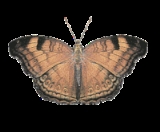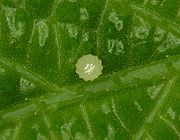
Junonia iphita
Encyclopedia
The Chocolate Pansy or Chocolate Soldier (Junonia iphita) is a butterfly found in Asia
.
It is about 5 centimetre in wingspan and the female can be told apart from the male by white markings on the oblique line on the underside of the hind wing. The wavy lines on the underside of the wings vary from wet to dry season forms.
Individuals maintain a territory and are usually found close to the ground level and often bask in the sun.

_w_vadodara_pix_017_.jpg) Upperside of both sexes brown of varying depths of colour. Fore wing: cell with one pair of subbasal and one pair of apical transverse sinuous fasciae, the outermost defining the disco-cellulars; a short, broad, dark, oblique fascia beyond to vein 4, its inner margin diffuse, its outer sinuous but sharply defined; below vein 4 a sinuous, transverse, more faint fascia, followed by a discal blackish fascia, very broad and diffuse, below costa, bordered by a row of faint ocelli, and a postdiscal and a subterminal similar fascia following the outline of the termen. Hind wing with a slender blackish loop near apex of cellular area; a broad inwardly diffuse, outwardly well-defined short discal fascia in continuation of the one on the fore wing; a series of postdiscal somewhat ochraceous ocelli with black pupils minutely centred with white; postdiscal and subterminal broad lines as on the fore wing.
Upperside of both sexes brown of varying depths of colour. Fore wing: cell with one pair of subbasal and one pair of apical transverse sinuous fasciae, the outermost defining the disco-cellulars; a short, broad, dark, oblique fascia beyond to vein 4, its inner margin diffuse, its outer sinuous but sharply defined; below vein 4 a sinuous, transverse, more faint fascia, followed by a discal blackish fascia, very broad and diffuse, below costa, bordered by a row of faint ocelli, and a postdiscal and a subterminal similar fascia following the outline of the termen. Hind wing with a slender blackish loop near apex of cellular area; a broad inwardly diffuse, outwardly well-defined short discal fascia in continuation of the one on the fore wing; a series of postdiscal somewhat ochraceous ocelli with black pupils minutely centred with white; postdiscal and subterminal broad lines as on the fore wing.
Underside brown, with very broad darker brown transverse fasciae, the interspaces between the markings irrorated with purplish silvery scales. Fore wing with two sinuous fasciae on basal half succeeded by a discal fascia, very broad at the costal margin and decreasing in width to the dorsum, bearing on its outer border a row of obscure ocelli. This is succeeded by a zigzag dark line, and sinuous subterminal and terminal lines ; apex and tornal area suffused with purplish silvery. Hind wing : two irregular, very broad, dark brown, curved short fasciae near base ; a straight, transverse, prominent, narrow ochreous-brown discal band defined outwardly by a black line ; a transverse postdiscal dark brown fascia, widest in the middle and bearing outwardly a curved row of ochreous-brown white-centred ocelli, followed by a zigzag dark line in continuation of the one on the fore wing; a subterminal somewhat diffuse dark fascia and a terminal dark line. Antennae, head, thorax and abdomen dark brown.

The eggs are often laid on the ground or on dry twigs near the host plants rather than on them. On hatching the larvae find their way to the host plants.
species recorded are Hygrophila costata
, Justicia micrantha, Justicia procumbens
, Justicia sphaerosperma, Lepidagathis formosensis, Strobilanthes callosus
and Strobilanthes formosanus.
Asia
Asia is the world's largest and most populous continent, located primarily in the eastern and northern hemispheres. It covers 8.7% of the Earth's total surface area and with approximately 3.879 billion people, it hosts 60% of the world's current human population...
.
It is about 5 centimetre in wingspan and the female can be told apart from the male by white markings on the oblique line on the underside of the hind wing. The wavy lines on the underside of the wings vary from wet to dry season forms.
Individuals maintain a territory and are usually found close to the ground level and often bask in the sun.
Description
- See glossaryGlossary of Lepidopteran termsThis glossary describes the terms used in the formal descriptions of insect species, jargon used mostly by professionals or entomologist....
for terms used

_w_vadodara_pix_017_.jpg)
Underside brown, with very broad darker brown transverse fasciae, the interspaces between the markings irrorated with purplish silvery scales. Fore wing with two sinuous fasciae on basal half succeeded by a discal fascia, very broad at the costal margin and decreasing in width to the dorsum, bearing on its outer border a row of obscure ocelli. This is succeeded by a zigzag dark line, and sinuous subterminal and terminal lines ; apex and tornal area suffused with purplish silvery. Hind wing : two irregular, very broad, dark brown, curved short fasciae near base ; a straight, transverse, prominent, narrow ochreous-brown discal band defined outwardly by a black line ; a transverse postdiscal dark brown fascia, widest in the middle and bearing outwardly a curved row of ochreous-brown white-centred ocelli, followed by a zigzag dark line in continuation of the one on the fore wing; a subterminal somewhat diffuse dark fascia and a terminal dark line. Antennae, head, thorax and abdomen dark brown.
Life history

The eggs are often laid on the ground or on dry twigs near the host plants rather than on them. On hatching the larvae find their way to the host plants.
Larva
"Cylindrical, slightly pubescent and armed with nine longitudinal rows of many-branched spines, except on the head which is clothed with short bristles. . . . Colour dark dull brown." (Davidson and Aitken.)Pupa
"is regular, with three or five dorsal rows of small tubercular points, hung perpendicularly.....Colour smoky brown."(Davidson & Aitken.)Larval food plants
The larvae feed on a variety of plants of the family AcanthaceaeAcanthaceae
The family Acanthaceae is a taxon of dicotyledonous flowering plants containing almost 250 genera and about 2500 species....
species recorded are Hygrophila costata
Hygrophila costata
Glush weed , or yerba de hicotea Glush weed (aka gulf swampweed), or yerba de hicotea Glush weed (aka gulf swampweed), or yerba de hicotea (syn. Hygrophila atricheta Bridar., Hygrophila brasiliensis Spreng., Hygrophila conferta Nees, Hygrophila guianensis Nees, Hygrophila lacustris Morong &...
, Justicia micrantha, Justicia procumbens
Justicia procumbens
Justicia procumbens, commonly known as Water Willow, is a small plant endemic to India.The juice of leaves is squeezed in the eyes in case of ophthalmia....
, Justicia sphaerosperma, Lepidagathis formosensis, Strobilanthes callosus
Strobilanthes callosus
Strobilanthes callosus Nees is a shrub found mainly in the low hills of the western ghats all along the west coast of India. Its standardized Hindi language name is Maruadona by which it is called in the state of Madhya Pradesh where it is also found...
and Strobilanthes formosanus.

